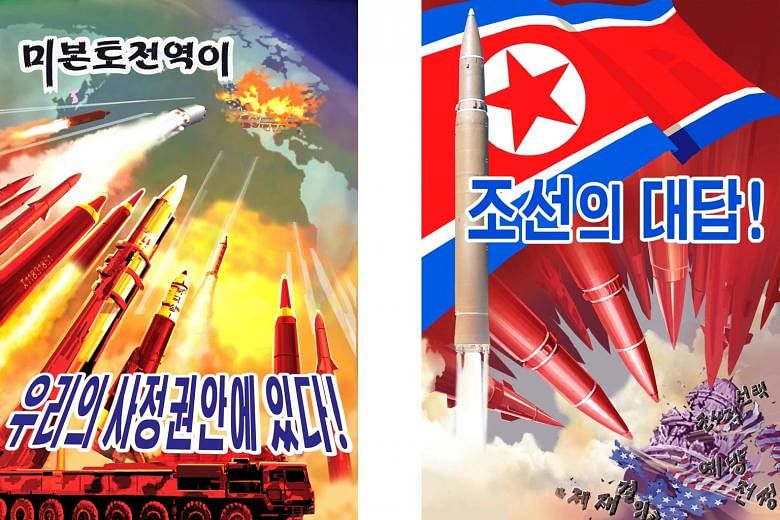NEW YORK • The language on the North Korean posters is as bombastic as the images are eye-popping and the colours blindingly bright.
One blue-lettered poster shows a barrage of missiles heading towards a map of the United States that is in flames. It boasts: "The entire mainland US is within our range!"
Another shows red missiles emerging from a North Korean flag, arrowing in on the US Capitol and American flag, both of which appear to be disintegrating. It carries the words: "Our answer!"
A third poster displays a red missile mounted on a giant red tank. It lambasts the United Nations sanctions and hails the North's self-reliance with the words: "No one can stop our march forward!"
The posters and defiant slogans were unveiled this past week, the latest sign that tensions remain high between Washington and Pyongyang over the North's nuclear ambitions and the sanctions imposed by other nations.
Political posters have long been an important feature of culture and daily life in the North. They are everywhere: on the walls of public buildings, at the gates of schools and at factories and collective farms. They are used to instil in North Koreans the tenets of party ideology and loyalty.
The KCNA state news agency did not say why the themes were chosen. But the posters were unveiled after US President Donald Trump warned North Korea that it would face "fire and fury" from a US military "locked and loaded" if the country made any nuclear provocations.
The North, in turn, threatened to launch four intermediate-range ballistic missiles into the waters near Guam, a US territory in the Western Pacific, to teach Mr Trump a lesson.
Pyongyang has long used posters and rallies to whip up anti-US sentiments and national fervour. They are mainly for domestic consumption, but these military-themed posters also send a message to President Kim Jong Un's perceived enemies abroad.
"What is typical in these posters is the image of an undaunted, fierce North Korea that is not fazed by the moves of the United States or the United Nations," Dr Koen de Ceuster, an expert on North Korea at Leiden University in the Netherlands, told Reuters.
"It reinforces the images of the strides North Korea made in missile capability and how North Korea is undaunted by any challenges to its sovereignty," he said.
Countries use various signalling techniques in times of crisis, experts in geopolitics say, including diplomacy, back-channel talks and public messaging.
The North is clearly sending a message with these posters. The tank symbolises "byungjin", its policy of seeking nuclear and economic development simultaneously.
The North has test-fired missile after missile, rattling the region. Then last month, the country tested an intercontinental ballistic missile that appeared capable of hitting the West Coast of the US - a milestone, experts said.
That led the UN to impose new sanctions this month that could slash the country's US$3 billion (S$4.1 billion) in annual export revenue by one-third.
Heated words resulted, and the leaders of Japan and South Korea scrambled to tamp down tensions. Top US general Joseph Dunford and President Moon Jae In of South Korea huddled in talks, saying they hoped to avoid armed conflict.
Since then, Mr Kim has appeared to back off on his threat to blast the waters around Guam. And Mr Trump has praised him for his "wise" decision. For now, the war of words has been muted. But a potential inflection point looms.
Today, US and South Korean troops will begin annual large-scale war games.
They are the first since the North test-fired missiles that might be able to reach the US mainland, and ones that the North previously vowed to match with nuclear strikes, not only at the US, but also at its military bases in North-east Asia.
NYTIMES

